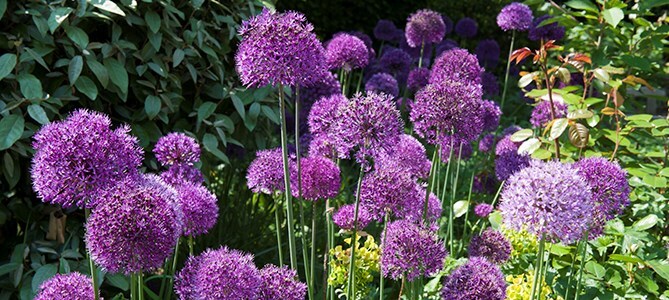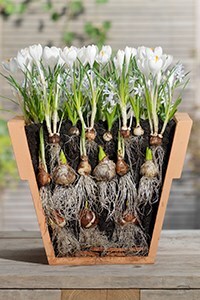Naturalising bulbs
Transform problem planting sites around the garden using the natural beauty of spring-flowering bulbs

Spring-flowering bulbs are one of the simplest and most effective ways of adding colour to the garden. By choosing the right combination of snowdrops, crocuses, daffodils and tulips, for example, you can achieve a succession of blooms from January through to May and if you add colchicums to the mix, you’ll also get a welcome reprise in autumn. For maximum impact, grow them in natural-looking drifts where they can be left to their own devices to spread and multiply. Best of all, naturalised bulbs require little or no maintenance and are an ideal way of tackling difficult to plant areas of the garden, such as under trees, skirting the base of a hedge or for turning patches of rough grass into a flowering meadow.
Where to plant naturalised bulbs
When selecting a site, choose one where the soil remains undisturbed and the bulbs can spread themselves about naturally. For this reason, it is impracticable to try to naturalise bulbs in borders that are regularly replanted, or amongst herbaceous perennials that require lifting and dividing every few years. In most gardens, the best places to naturalise bulbs are in rough areas of grass, under the canopy of deciduous trees and shrubs, alongside a hedge or over banks. Little or no cultivation should be carried out except to control weeds and mow grass once the bulbs have died down for the summer.
Flowering meadow Natural-looking flowering meadows are easiest to achieve on poor, impoverished soil where the grass is a little less vigorous allowing the bulbs and wildflowers to thrive. If you just want an early show of naturalised bulbs, so you can then reclaim the lawn during the summer months, choose bulbs that flower during late winter and early spring, such as snowdrops early crocusesand Siberian squills. You can then start mowing by mid-April. If you fancy planting some later flowering bulbs, such as daffodils, bear in mind that you will have to leave the grass uncut for six weeks after the daffodils finish their display, as this allows the bulbs time to replenish their resources in order to flower reliably the following year. If you are prepared to leave the grass uncut for longer, you can grow a wide range of bulbs including fritillaries, colchicums, grape hyacinths and spring snowflakes. Perhaps the best way of achieving this in a garden, is to cluster the bulbs in swathes covering just part of the lawn or as a fringe along one edge. The rest of the lawn can then be trimmed as normal.
Dappled carpets Uncultivated areas under deciduous trees and shrubs, as well as fringing a hedge are ideal sites for naturalising bulbs. The key to planting underneath the canopy of a tree, is to choose a bulb that finishes flowering well before the tree comes into leaf. That way, they will get sufficient light to replenish energy reserves before being shaded heavily. The later the tree comes into leaf and the more open it’s canopy, the greater range of bulbs you can consider. For these reasons, the best trees to underplant with naturalised bulbs include ash, birch and oak. Although you can try a range of different bulbs, for an authentic woodland glade it’s hard to beat anemones, bluebells, aconites and dog’s tooth violets. Uncultivated ground amongst shrubs is another naturalising opportunity in many gardens. Here, plant in clusters to add colour and interest during early spring. You can even try naturalising bulbs amongst perennials that resent root disturbance and are left undisturbed once planted. Ferns, hostas and peonies all come to mind. Better still, these late-emerging perennials will help disguise the untidy foliage of the fading bulbs, reducing the need for maintenance further.
How to grow bulbs naturally

Planting Most dry spring-flowering bulbs should be planted straight away after purchase – usually August or September. This allows the bulbs sufficient time to put down some roots and get established before the onset of winter. The exception to this rule, is the tulip, which is best planted during late autumn to help avoid disease. Snowdrops, on the other hand, are best transplanted after flowering while still in leaf (known as ‘in the green’), but can also be planted during late summer as dry bulbs. Small, dried bulbs of anemones, fritillaries and dog’s tooth violets are best placed in moist compost for a day or two to absorb moisture before planting.
The aim when planting, is to create as natural a swathe of flowers as possible, so plant them in sweeping patterns at irregular spacing intervals, using an uneven number of bulbs. To achieve a natural variation in planting density, try setting out bulb clusters closer together at the centre of each planting pattern, with radiating elements spaced more widely. Do not mix different bulbs in the same cluster as this will undermine the natural effect. Alternatively, use the often recommended technique of scattering the bulbs randomly on the surface and planting them exactly where they land. Make sure each type of bulb is planted at the correct depth. As a rule of thumb, plant all bulbs so that they are covered by twice as much soil as the depth of the bulb. So that a 1cm-high crocus bulb should be planted in a 3cm hole, and a 4cm-high daffodil bulb in a 12cm hole.
When planting in established grass, either use a crowbar or metal stake to make individual holes for small bulbs, or use a special bulb planter that removes cores of soil, for larger ones. Alternatively, cut out turves or strip back the whole area to bare soil, replacing the turves again after planting the bulbs.
Aftercare Naturalised bulbs require the minimum of aftercare. On bare soil, you may have to hand weed in spring while the bulbs are still growing, but weeds can be removed using a hoe once the bulbs are dormant. Old bulb foliage can also be removed once it turns brown if it looks unsightly. It’s also a good idea to mulch the surface of the soil with well-rotted organic matter to help keep the weeds down. Where there is a lot of competition from roots, such as alongside a hedge, or under the canopy of surface-rooting trees and shrubs, apply a slow-release fertiliser, such as bonemeal, once a year, in autumn, to give the bulbs a boost. If growing bulbs in grass, mowing can commence six weeks after flowering. Do not feed bulbs in lawns since this will just encourage excessive grass growth. Also avoid aerating the lawn or applying weedkillers while the bulbs are visible.